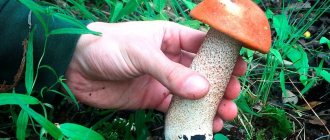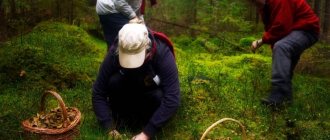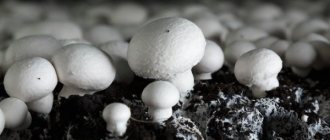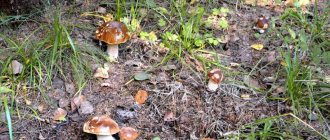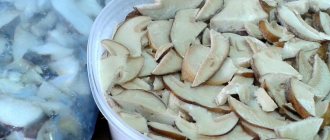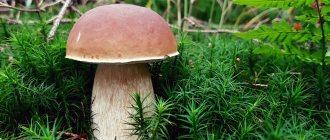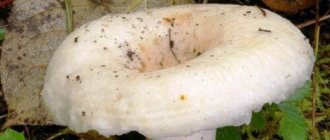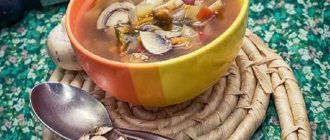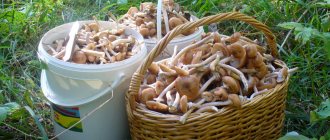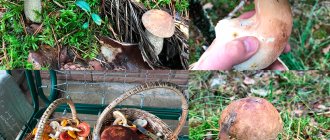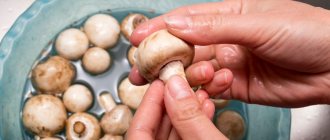A little history about mushrooms in the Ryazan region. In the 50s of the last century, forest clearings began to be created in the arid steppes of southern Russia in order to soften the climate and make it more humid. But the trees in central Russia did not take root well, despite fertilizers and watering.
Then they tried to completely recreate the conditions in which deciduous and coniferous trees common on the Central Russian Plain grow, including introducing into the soil the spores of well-known mushrooms - boletus, boletus and boletus. Tree seedlings began to develop normally, accumulating enough nutrients to survive the winter and turn green in the spring.
This is how biologists became convinced that trees and mushrooms have close cooperation. But not with fruiting bodies decorated with caps, which we usually call mushrooms, but with myceliums that hide underground and can grow tens of meters. Biologists called this collaboration “mycorrhiza” (Greek for “fungus root”). It consists in the fact that hyphae (the thinnest processes of the mycelium) penetrate the small roots of the tree, are located between the cells and begin a mutually beneficial exchange.
Expert opinion
Melnikov Vladimir Mikhailovich
Knows 1000 ways to cook, pickle and marinate any types of mushrooms
Having settled on the roots and penetrated inside, the fungus enhances the absorption function of the tree and processes nutrients into more easily digestible forms, including sugars. It also produces something like growth stimulants and even antibiotics, protecting trees from pathogenic bacteria and pathogenic fungi.
What mushrooms are found and actively grow in Ryazan?
The beginning of mushroom germination in the Ryazan region is no different from the regions located in central Russia, the central part and even in the south. The deviation in numbers may lag by one or two weeks or, on the contrary, rush, depending on the cyclone that has settled in the region.
Based on the volume of the harvest, based on real reviews left on forums and social networks: VK, Odnoklassniki, Instagram, we can conclude that there are no less mushrooms in Ryazan than in the Moscow region and Kuban. Depending on the forest belt, with sprouting coniferous, deciduous or mixed trees, fruiting may vary. It is better to collect fruits in baskets or buckets so that the pulp cannot be deformed, remaining fresh and aromatic for as long as possible.
The most popular mushrooms in 2022 were both conventional and edible varieties:
- boletus;
- obabkov (boletus and boletus);
- champignons;
- saffron milk caps;
- spring, summer, autumn honey mushrooms;
- oily in the spring months and autumn;
- chanterelles;
- rows;
- russula;
- milk mushrooms
Fans of snotty butterflies who don’t regret wasting time cleaning the fruits should look for mushrooms in the plantings of young Christmas trees. Pine plantings remain the best options for collection. The only alternative is tall grass growing near a coniferous forest.
If you want to collect boletus, boletus and boletus, it is better for the collector to go to the deciduous or mixed zone in mid-September, when hot days give way to high humidity and a cool climate.
To prepare tender pates and hot salads, it is better to give preference to tender mushrooms, suitable for frying and grinding through a meat grinder. Among the options: chanterelles, honey mushrooms, saffron milk caps, champignons, oyster mushrooms.
If you want to close the marinade or freeze mushrooms for the winter, it is better to give preference to noble breeds, especially white and Polish.
How, where and when residents of Ryazan collect a rich mushroom harvest
Mushrooms are the most mysterious form of life.
They are not classified as plants, animals or insects, but are classified as a separate kingdom. Their age is more than 400,000,000 years. Residents of Russia annually wait for the right season to quickly go for forest gifts, and Ryazan residents are no exception. The territory of the Ryazan region is famous for its rich mushroom places. But every collector should remember that out of the entire variety of mushrooms, only 300 species on the planet are considered edible. As you know, the most expensive is truffle, and the most popular are champignons and chanterelles.
A correspondent for the Internet portal “Ryazan.Life” contacted avid mushroom pickers in the region and talked with them. Most often, the knowledge of gatherers is limited to basic things, but this is not about our interlocutors - they will tell you about gadgets for the forest, and choose the right clothes, and share secret places, and tell you delicious recipes.
Victoria Malysheva, for example, has lived in Ryazan for many years and works as a teacher in a kindergarten. Hard work and a friendly family do not prevent her from doing what she loves - picking mushrooms, but, on the contrary, they even help. Victoria storms the forest quite often, but admits that she would like to do it even more often. According to her, she mostly goes with her husband or friends to catch her catch; she never goes into the forest alone. To the question “What is the secret of a big catch?”, he answers:
“There is only one secret in the forest: don’t go where you don’t know!” I don’t go far, I highlight some special places and landmarks. My husband installed an additional program on his phone that connects to the car.”
The woman also noted that the forest relaxes, frees the brain from unnecessary problems and worries, and allows you to enjoy nature and air.
We also learned from Victoria about the “equipment” of a true mushroom picker - these are necessarily pants, a long-sleeved jacket, and sneakers or boots on the feet, but the gatherer prefers the first option, regardless of the weather. Her dad taught her to pick mushrooms, although, as it turned out, he himself didn’t know them at one time. As for the harvest itself, a woman can distinguish poisonous species from edible ones - this does not cause her problems. Many beginners are interested in the question: “How to pick mushrooms correctly?” Victoria believes that it is better to cut them off, as this will cause less damage to the entire mycelium. Perhaps the mushroom spores will give a new harvest later.
“To be honest, I rejoice at all the mushrooms, to find one in the middle of the forest and no matter how edible it is, it’s a whole mushroom, and that’s great! Our family really loves boletuses, they are very beautiful to find, and when cooked they retain their strength and aroma. And so, of course, the white one, but we find them very rarely... so our preference is for the redhead,” the interlocutor said.
Victoria also shared with our readers the “golden” places where a lot of mushrooms grow. According to her, each mushroom picker has his own place. She can recommend the Spassky district, surrounded by the village of Fedotevo. Areas such as Starozhilovskoy, Klepikovsky and Shilovsky are also rich in mushrooms.
The whole family of the collector loves “Julienne”. They prepare it according to the following recipe : fry onions, add mushrooms, then pepper, salt, pour in cream, wait for the cream to boil. Then put it in a special oven dish, sprinkle cheese on top and bake for 20 minutes.
Homemade Victorias also love breasts stuffed with mushrooms, as well as mushroom caviar.
Poisonous and inedible mushrooms
In addition to edible prey, a beginner, unknowingly, can collect life-threatening mushrooms that contain not only poison in their pulp, but also toxins and carcinogens. In the forests of the Rostov region there are no less of them than useful ones, famous for their captivating aroma and taste. Pale grebe, the fly agaric family, false honey mushrooms and umbrellas are only a small part of what a mushroom picker may encounter when going on a quiet hunt. Therefore, in order to avoid making the critical mistake of many beginners who have received poisoning, you should carefully study the description and distinctive features of each mushroom.
Despite the fact that fly agarics can germinate almost anywhere, they are most often found in a mixed zone where deciduous and coniferous trees germinate. Their bright color often scares away many people, but there are also cases when the print on the hat is washed off after rain. Instead of white peas, the cap becomes monochromatic, reminiscent of a marsh russula. To avoid confusion, you should know other differences.
Mushroom pickers are also wary of other poisonous mushrooms, namely: false honey mushrooms and toadstool. They often germinate near edible fruits, thereby confusing beginners who doubt during the first and second quiet hunt.
Mycologists always recommend collecting only familiar mushrooms that meet all the distinctive characteristics. If you have the slightest doubt about the consistency of the signs, you should pass by, leaving the wicker basket not completely filled.
Important!
Despite the fact that not all poisonous mushrooms smell bad and have a skirt on the stem, most subspecies that contain poisons and toxins in their pulp are discouraged from being collected by these two criteria.
Edible varieties
boletus
One of the favorites among mushroom pickers. The color of the cap is from light gray to brown, the leg is gray-white, scaly. Prefers birch forests, also found in mixed forests.
In all types of boletus, the cut flesh does not change its color under the influence of atmospheric oxygen. Since all species are edible, very often mushroom pickers do not distinguish between them, uniting them under one name - “boletus”. Only the most inquisitive try to find out the characteristics of each species in order to find out where and when it is best to collect them, which means returning from the “quiet hunt” with a full basket.
Collected from early summer to late autumn. A rich harvest of boletus can be collected even in young birch forests.
Boletus
It comes in red, yellow-brown and pine. They differ from boletus mushrooms in having a thicker stem and a dense cap. The color of the cap is red-orange (rarely white), the stem is velvety, white. A characteristic feature is that the flesh becomes bluish-black when cut.
Collected from June to October in aspen forests. It is also found in mixed and pine forests.
Porcini
Boletus has an excellent nutty taste. The color of the cap is from whitish to dark brown, the leg is thick, massive, slightly lighter. The pulp is dense, white.
People believe that the white mushroom and the fly agaric go hand in hand with each other: if fly agarics have appeared, you can go in search of the white mushroom.
Grows from June to October in deciduous, coniferous and mixed forests. Fruits in waves.
Milk mushrooms
They are distinguished by their special cap shape: pressed in the center with curved fringed edges. The color of the cap of different species can be white, light brown, golden, or black. The leg is short.
The mushroom hides under fallen leaves and is found in large groups towards the end of summer and autumn in deciduous, coniferous and mixed forests.
Milk mushrooms form mycorrhizae with a number of tree species, in particular with birch, spruce and willow.
Chanterelles
It can be recognized by its unusual shape, reminiscent of an umbrella turned outward: the cap is almost completely fused with the stem.
Chanterelle is one of the most famous edible mushrooms. As with champignon, successful experiments were carried out with it in the early 1970s on growing the mycelium of these mushrooms using the “deep cultivation” method. Everything went well from the point of view of high biological productivity, but an insurmountable obstacle was the complete lack of specific taste and aroma of the “artificial mushrooms.”
The color of the mushroom ranges from light yellow to bright orange. Found from June to October, growing in families.
Russula
Small fragile specimens with a white stem and a cap of various colors (white, pink, green, yellowish, light brown, gray, black). The skin of the cap is usually dry and only sometimes cracks. Collected from mid-summer to late autumn in deciduous and mixed forests.
Some species are conditionally edible, so it is recommended to soak or boil them before cooking.
Butter
They got their name from the slippery, oily cap of young mushrooms, covered with an easily removable skin. Its color ranges from yellow to dark brown, the leg is slightly lighter. It is yellow below (it darkens in older mushrooms) and consists of thin tubes.
Collected from early summer to mid-autumn, most often found in coniferous forests.
Honey mushrooms
Can be found on old stumps, fallen tree trunks, and just on the ground. The cap is light yellow to dark brown, the thin leg is slightly lighter, and has a characteristic skirt.
They grow in large groups in the forest from early summer to late autumn.
Mushroom places on the map with photos
You can find mushrooms in 2022 in any forest where trees sprout. However, in order to collect as many mushrooms as possible, you should study the map of mushroom places in the Ryazan region in advance to find out favorable places for quiet hunting, characterized by fertile soils and clean air, which influence the active growth of myceliums almost all year round, with the exception of cold weather in winter, when the air temperature drops below 3 degrees below zero.
The best places to gather are:
1) forest zones located near two lakes: Chernenkoe and Segdenskoe. You will be able to pick there both noble breeds and conditionally edible varieties. The deciduous zone will allow you to collect a lot of boletus and mushrooms, summer and meadow mushrooms, rows and russula;
2) the village of Laskovo or the village of Deulovo, located far from the city limits. Mixed forests will allow you to collect different mushrooms, both in spring, summer and autumn;
3) the Iberd forest, famous for the germination of milk mushrooms, tasty and aromatic chanterelles and even hygrophores, would be a good place to gather in the coniferous forest;
4) last year pleased mushroom pickers with the presence of most species of mushrooms. In the village of Tuma, not only edible and noble species were found, but also conventional ones, germinating not only in plantings, but also in open areas;
5) An alternative option for the trip would be to pick mushrooms in the forest area of the village of Shelukhova.
6) You can look for summer and autumn mushrooms in the village of Zadubravye or a remote village in the Kasimovsky district called Kochemary. Fruiting in their zones continues for many months, until the end of winter, provided that the air temperature remains abnormally warm.
Useful for mushroom pickers!
To collect full baskets of mushrooms and get out of the forest without being bitten by ticks and snakes, you should follow simple recommendations: choose the right clothes, stock up on a snack and a thermos with delicious tea, anti-bite spray and containers for collection.
Other places
- Fedotevo village: surrounded by birch groves, where you can find not only boletus, chanterelles, honey mushrooms, but also porcini mushrooms. The settlement is located in Spassky Forests.
- Kriusha village: this settlement is rich in forests. They not only contain a lot of mushrooms, but also berries. Cranberries here can grow in abundance in the marshy lowlands of the area.
- Ungor village: located next to small forests, where mushroom pickers come every year. Oddly enough, few forest mushrooms are found in ordinary forests in this area.
- Nazarovka village: located next to the forest, where mushroom pickers most often come across boletus mushrooms. This area is located in the Chuchkovsky district.
- The village of Tuma: is surrounded by forests in which fruit bodies of various types are found - from white to milk mushrooms and russula. These places are located in the Klepikovsky district. It’s also worth visiting the landing near the village of Tyukovo. In addition to the main noble (tubular) species, in this area baskets are filled with chanterelles and moss mushrooms.
- the villages of Polyany, Korostovo, Zaokskoye in the Kasimovsky direction: near them there are meadows where honey mushrooms, champignons, and raincoats are collected. Agricultural deserts are the most popular place among mushroom pickers.
- Solotchinsky coniferous forest: besides white chanterelles and chanterelles, you can find a lot of boletus and russula. Moving towards the village of Polkovo, they replenish their basket with milk mushrooms, saffron milk caps, and morels.
- village of Zaokskoe: here they not only swim and enjoy outdoor recreation, but also pick mushrooms. Usually they return home from the Lukovsky forest with a rich harvest. The village is located just 20 minutes drive from the regional center.
The addresses of all settlements in Ryazan, near which mushrooms are collected, are constantly updated.
Important Tips
1) Unfortunately, in recent years many forests have become increasingly polluted. To avoid indigestion or worse, poisoning, you should collect only young fruits that are not exposed to toxins and carcinogens.
2) To reduce competition, it is preferable to go to the forest zone in the morning hours on weekdays, when most local residents of the Ryazan region are at work.
3) When collecting conventional and edible fruits that require heat treatment, do not rush, spending less time than recommended in the recipe.
4) Any recipe involves using one type of mushroom. You should not pickle several conventional or edible species at once.
5) Clothing for searches must be closed, preventing insect bites.
Tips for beginners
To get only the benefits from mushrooms, you must follow the collection rules. Experienced mushroom pickers recommend going out into the forest early in the morning, especially in summer. The largest number of fruiting bodies are collected 2-3 days after rain.
Mushrooms are collected only with stems. It is by the legs that poisonous species are identified during sorting. If you decide to buy more mushrooms, pay attention to the fact that the caps must have stems. If the seller offers only “heads” of mushrooms, refuse to purchase. You will not be able to accurately determine whether the mushroom in front of you is a poisonous or an edible one.
Photo of mushroom harvest:
2022 promises a rich mushroom harvest in the Ryazan region. Already from mid-spring, local residents leaving reviews on the forum noted the good fruiting of honey mushrooms and honey mushrooms. What will happen next is not yet clear, but the forecasts for the summer and autumn are positive.
